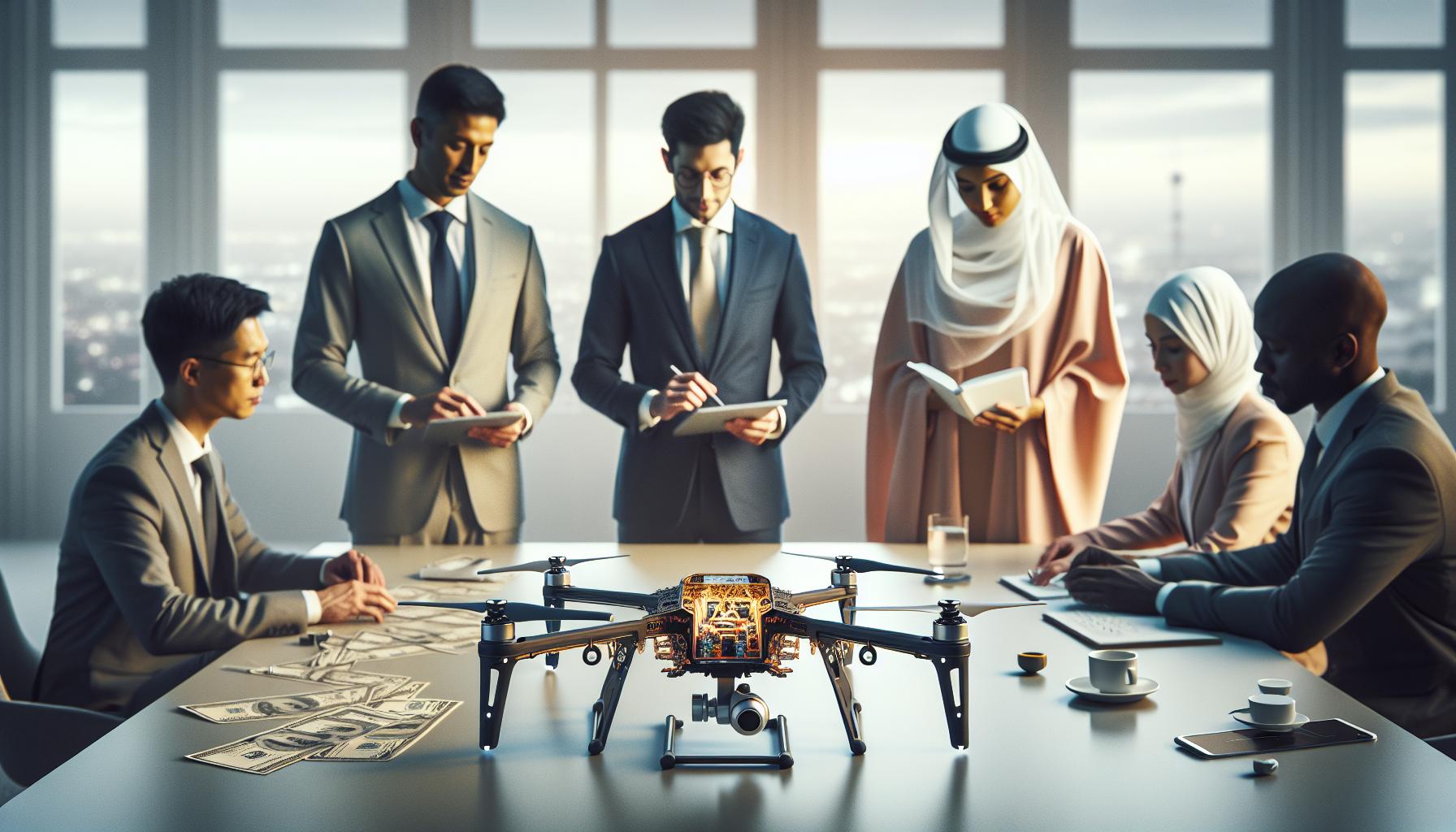When it comes to aerial innovation, DJI stands out as the leading name in drone technology. Founded in 2006 by Frank Wang, who revolutionized the industry from his university dorm room, DJI has become synonymous with quality, from consumer-friendly models to advanced professional UAVs. Understanding the ownership and leadership behind this influential company not only sheds light on its strategic decisions but also on its commitment to pushing the boundaries of drone capabilities. As a drone enthusiast or professional operator, knowing who steers this industry giant can enhance your insight into the products you love and utilize. Dive into the exploration of DJI’s ownership structure and leadership to see how they shape the future of drones, guiding users to harness their full potential in various applications-from photography and filmmaking to surveying and beyond.
Who Owns DJI? Understanding Company Ownership Dynamics
DJI, founded in 2006 by Frank Wang, is a privately held company that has risen to become a dominant force in the global drone market. Understanding the ownership dynamics of DJI involves recognizing its structure as a private enterprise, primarily backed by venture capital investments. The company has benefited from significant funding rounds led by notable investors such as Sequoia Capital and Accel Partners, which not only infused capital but also strategic guidance, positioning DJI at the forefront of drone innovation and market leadership.
The private ownership status of DJI allows it a level of operational flexibility that public companies often lack. This agility has enabled DJI to rapidly iterate on product development and respond to changing market demands without the burdens of public scrutiny and shareholder pressure. However, the company is still required to comply with various regulatory frameworks, especially given the increasing scrutiny on drone operations and technology globally. The ownership structure also fosters a strong connection between leadership and innovation, as Frank Wang and his executive team remain deeply involved in the company’s strategic direction.
Moreover, DJI’s ownership impacts its brand image, as it is often perceived not just as a manufacturer but as a pioneer in aerial imaging technology and drone usage across various sectors-from filmmaking to agriculture. The company’s commitment to quality, performance, and reliability mirrors its leadership’s vision and dedication. This alignment of ownership and operational focus has cemented DJI’s reputation and bolstered consumer trust among both hobbyists and professional operators in the drone community.
The History and Evolution of DJI
In just over a decade, DJI has transformed from a small startup into a household name synonymous with consumer and professional drone technology. Established in 2006 by Frank Wang, a passionate engineer who started the company in his university dorm room, DJI initially focused on developing flight control systems for remote-controlled helicopters. This foundational technology proved to be the springboard for the company’s subsequent groundbreaking innovations in aerial imaging and consumer drones.
With the launch of the Phantom series in 2013, DJI revolutionized the drone industry by making sophisticated flight technology accessible to the masses. This marked a significant shift in how aerial photography and videography could be achieved, enabling hobbyists and professionals alike to capture stunning aerial footage without needing extensive technical knowledge. DJI’s commitment to user-friendly interfaces and robust features set new benchmarks for drone performance, expanding the appeal of drones beyond just enthusiasts to filmmakers, real estate agents, and even agricultural professionals.
DJI’s history is also marked by a series of strategic innovations and product releases that further solidified its market leadership. The introduction of the Inspire series brought professional-grade drones with innovative capabilities like dual operator control and interchangeable cameras, catering specifically to the burgeoning film and television industry. Meanwhile, the Mavic series, known for its portability and advanced features, tapped into the growing demand for drones that could easily be transported without sacrificing performance. Each new model not only enhanced existing technologies but also integrated cutting-edge advancements such as obstacle avoidance and intelligent flight modes, keeping DJI ahead of evolving consumer and industry needs.
As the drone market has matured, DJI has adeptly navigated challenges, including regulatory scrutiny and rising competition. The company’s proactive approach to compliance and its investment in education and community engagement have helped maintain consumer confidence and loyalty. By continuously innovating while staying true to its foundational values of quality, performance, and reliability, DJI has built an enduring legacy in the drone industry, positioning itself as a leader poised to shape the future of aerial technology.
Key Figures in DJI Leadership
Frank Wang, the co-founder and CEO of DJI, stands as a pivotal figure in the company’s illustrious journey from a tech startup into a major player in the global drone market. With a vision rooted in innovation and accessibility, Wang has propelled DJI to lead the aerial technology space. Under his guidance, the company has pioneered numerous technological advancements that have set industry standards. Wang’s engineering background and entrepreneurial spirit have been instrumental in developing the robust software and hardware ecosystems that define DJI’s products today.
In addition to Wang, other key leaders have played significant roles in shaping DJI’s corporate strategy. Roger Lo, the Chief Financial Officer, has facilitated DJI’s expansive growth through strategic financial management and investment planning. His expertise ensures that DJI not only maintains sustainable operations but also positions itself for future innovations. Fang Zhen, Vice President of Engineering, has overseen product development cycles that integrate cutting-edge technologies like machine learning and advanced imaging systems. This commitment to R&D is evident in the continual product enhancements seen in DJI’s portfolio, including the latest versions of the Mavic and Phantom series.
DJI’s leadership team is further strengthened by Liu Yuxin, who manages global marketing efforts. Her strategies enhance brand visibility and reinforce customer engagement around the world. This dynamic marketing approach has allowed DJI to tap into various sectors beyond consumer photography, including industries like agriculture and public safety. Collectively, these leaders embody a blend of engineering acumen and business savvy, driving DJI’s mission to empower users with advanced aerial tools.
The combined influence of these figures ensures that DJI not only remains a front-runner in the drone industry but also continues to innovate in ways that align with evolving market demands. By fostering a culture of collaboration and creativity, DJI’s leadership is dedicated to enhancing user experiences and expanding the horizons of what aerial technology can achieve.
DJI’s Corporate Structure and Organization
Understanding the inner workings of DJI (Dà-Jiāng Innovations Science and Technology Co., Ltd.) provides crucial insights into what makes this company a titan in the drone industry. Founded in 2006 by Frank Wang, DJI has expanded significantly from its humble beginnings in Wang’s university dormitory to becoming synonymous with high-quality consumer and professional drones. The company’s corporate structure is pivotal in maintaining its innovative edge while navigating the complexities of global markets.
At the heart of DJI’s organization is a strong commitment to research and development, evidenced by substantial investment in engineering talent and technology. The company retains a hierarchical structure where key leaders, such as the CEO Frank Wang and CFO Roger Lo, steer strategic initiatives. The core departments-Engineering, Marketing, and Customer Support-work collaboratively, ensuring that product development aligns with market needs and customer feedback. For instance, Fang Zhen, the Vice President of Engineering, leads various teams that focus on integrating advanced technologies like machine learning into DJI’s drones, enhancing both user experience and product capabilities.
DJI operates with a global reach, characterized by regional offices and partnerships that facilitate localized customer engagement and compliance with regulations in diverse markets. This international organizational framework allows DJI to be agile in its operations, adapting swiftly to changes such as regulatory landscapes and competitive pressures. Furthermore, the company’s commitment to user-centric design and innovation is reflected in its robust ecosystem of products that caters to both amateur and professional pilots alike, ranging from drones like the Mavic series to enterprise solutions in sectors like agriculture and public safety.
Ultimately, underscore its relentless pursuit of innovation and excellence, balancing between rapid growth and sustainable practices. By fostering a culture of creativity and focused leadership, DJI not only continues to set industry standards but also significantly influences the future direction of aerial technology.
Financial Overview: DJI’s Market Position
The financial landscape of DJI is a testament to its dominance in the drone market, reflecting both its innovative spirit and strategic positioning. As a privately held company, DJI’s precise financial data isn’t publicly disclosed, but estimates suggest that its market share in the consumer drone industry is around 70% to 80%. This impressive figure showcases the brand’s powerful presence and the trust it has garnered from consumers and professionals alike.
DJI’s revenue streams are diverse, generated from a range of products that include not only drones but also cameras, stabilizers, and software solutions. The continuous introduction of innovative products, such as the Mavic and Air series, alongside specialty drones for enterprise use, has helped maintain steady growth. For context, analysts project the global drone market could reach up to $43 billion by 2024, positioning DJI strategically to capitalize on this burgeoning demand through continued innovation and product diversification.
Another aspect contributing to DJI’s financial health is its commitment to research and development. The company allocates a substantial portion of its budget to R&D efforts, which not only drive product improvements but also maintain DJI’s competitive edge in a rapidly evolving market. For example, technological advancements in AI and machine learning have been incorporated into products to enhance user experience and operational capabilities, which can attract a wider consumer demographic and bolster sales further.
Additionally, DJI’s global reach influences its market position positively. By establishing a strong presence across various regions, including North America, Europe, and Asia, the company effectively mitigates risks associated with economic fluctuations in any single market. This strategic localization allows DJI to optimize its operations and cater to specific regional demands, thus ensuring consistent revenue generation.
In conclusion, DJI’s market position reflects its strategic investments in product innovation, a robust global presence, and a keen understanding of consumer needs, positioning the company for sustained future growth in a competitive landscape.
Innovations Driving DJI’s Success
Experience in drone technology has shown that DJI consistently pushes the envelope of what’s possible, merging advanced engineering with user-centric design. As the undisputed leader in the consumer drone market, innovation is not just an aspect of DJI’s strategy-it is its lifeblood. The company’s commitment to integrating cutting-edge technology into its products has transformed the way enthusiasts and professionals alike capture aerial footage and gather data.
A few key innovations have set DJI apart from its competitors. The introduction of intelligent flight modes such as ActiveTrack, which allows drones to autonomously follow subjects, and Waypoints, enabling pre-programmed flight paths, has elevated the user experience significantly. These features simplify complex flight maneuvers, making advanced aerial photography accessible even to beginners. Furthermore, DJI’s development of obstacle avoidance systems has drastically improved flight safety, allowing drones to navigate complex environments with minimal pilot intervention.
Advancements in Camera Technology
At the heart of DJI’s success is its relentless focus on enhancing camera capabilities. The integration of high-resolution sensors, gimbal stabilization technology, and low-light performance features into drones like the Mavic series has redefined photography and videography standards in the industry. Take, for instance, the Mavic 3, which boasts a Hasselblad camera that delivers stunning 5.1K video and exceptional image quality. Such advancements not only cater to professional filmmakers but also empower amateur photographers to achieve results previously reserved for high-end equipment.
Artificial Intelligence and Automation
DJI is also at the forefront of utilizing artificial intelligence (AI) to enhance drone functionality. Innovations like Smart Photo and Mastershots automatically optimize image settings and create professional-quality videos with minimal effort from the user. This not only streamlines the filming process but also allows users to focus more on creativity than on technicalities.
In essence, DJI’s innovations reflect a deep understanding of the evolving needs of their user base. By continually investing in R&D and prioritizing user-friendly designs, DJI has fostered a strong sense of loyalty among its customers. As the company continues to break new ground, the future promises even more incredible advancements that will further consolidate DJI’s position as the leader in drone technology.
Exploring DJI’s Product Range: Drones and Beyond
The vast array of products from DJI extends far beyond the iconic drones that have garnered global acclaim; it encompasses a diverse portfolio designed to serve both hobbyists and professional users alike. DJI’s mastery in drone technology is complemented by their commitment to creating tools that enhance aerial imaging, video production, and even industrial applications.
DJI’s drone lineup primarily features popular series such as the Mavic, Air, and Phantom, each catering to distinct use cases. The Mavic series, known for its compact and foldable designs, includes models like the Mavic Air 2 and Mavic 3, which boast impressive camera capabilities and intelligent flight modes. These drones are ideal for travelers and outdoor enthusiasts who require portability without sacrificing quality. Conversely, the Phantom series remains a staple among filmmakers and professionals, known for its robust build and superior stabilization systems, making it a first choice for cinematic aerial shots.
Beyond Drones: Expanding Product Ecosystem
While DJI is synonymous with drones, the company has also ventured into a broader range of products that enhance the overall flying experience. Gimbals like the Ronin series are designed for stabilizing cameras, ensuring smooth footage that can pair seamlessly with drone videography. Additionally, DJI offers a variety of accessories, including intelligent flight batteries, propeller guards, and carrying cases, which are essential for both safety and operational efficiency.
Moreover, innovations such as the DJI Matrice series cater to enterprise applications, offering advanced features like thermal imaging and payload capabilities that are crucial for industries ranging from agriculture to search and rescue operations. This diversification demonstrates DJI’s dedication to not only improving the consumer experience but also delivering sophisticated solutions that address the specific needs of various sectors.
Intuitive Software Integration
To round out their product offerings, DJI has invested heavily in software solutions that integrate seamlessly with their hardware. The DJI Fly and DJI GO apps provide users with intuitive interfaces to manage flight settings, access editing tools, and share creative content effortlessly. These applications enhance user experience by providing real-time data on flight metrics, while also allowing operators to configure intelligent modes such as Follow Me and Waypoints, making complex aerial tasks accessible to users at all skill levels.
In essence, DJI’s product range illustrates a comprehensive approach to aerial technology that not only emphasizes user-friendly designs and robust capabilities but also reflects their innovative spirit and commitment to meeting the needs of an evolving market. Whether it’s capturing stunning visuals from the sky or equipping enterprises with critical data, DJI continues to push boundaries, revealing the extraordinary potential of drone technology.
Global Presence: Where DJI Operates
DJI’s influence extends far beyond its headquarters in Shenzhen, China, positioning itself as a global leader in the drone industry with a recognizable brand that resonates in markets across continents. With operations spanning North America, Europe, Asia-Pacific, and beyond, DJI not only promotes its advanced drone technologies but also integrates into local markets with tailored solutions for both recreational and professional users. This expansive reach allows DJI to cater to a diverse customer base that includes filmmakers, agricultural specialists, industrial users, and hobbyists.
In North America, DJI has established a robust presence with a dedicated focus on professional drone applications, including aerial cinematography and agricultural surveying. The company frequently collaborates with local enterprises to develop customized drones that meet specific industry needs, such as enhanced thermal imaging for search and rescue or surveying capabilities for construction projects. Meanwhile, in Europe, DJI faces various regulatory challenges but has successfully launched initiatives to educate users about compliance with standards and safety protocols, thereby fostering a responsible drone operating culture.
Understanding regional differences is pivotal for DJI’s strategy. In Asia, where technological adoption is rapid, DJI focuses on innovative features that appeal to tech-savvy consumers, like obstacle avoidance and AI-powered flight modes. Conversely, in markets that are still overcoming regulatory hurdles, DJI emphasizes safety education and responsible usage, partnering with local authorities to promote best practices in drone operation and ensure adherence to national regulations.
Ultimately, DJI’s global presence underscores not only its role as a market leader but also its commitment to adapting and evolving in response to the unique needs and challenges of different regions. Through education, collaboration, and innovative technology, DJI continues to shape the future of aerial photography and industrial applications worldwide, reinforcing its brand as a pioneer in the drone industry.
Competitors in the Drone Industry
The drone industry is a dynamic landscape characterized by intense competition, with various players striving to capture market share and innovate. DJI, as the dominant force, holds a significant portion of the global market, but it faces challenges from both established companies and agile startups. Understanding these competitors is essential for anyone interested in the aerial technology sector, whether you’re a consumer looking to purchase a drone or a professional involved in the industry.
Major Competitors
Several notable companies present strong competition to DJI, each offering unique products that appeal to different segments of the drone market:
- Parrot – A French company renowned for its consumer and commercial drones, Parrot has carved a niche with models like the Anafi series, which emphasize portability and advanced camera capabilities.
- Autel Robotics – Known for its EVO series drones, Autel focuses on high-quality imaging and competitive pricing, making it a favorite among serious enthusiasts and professionals.
- Skydio – An American startup, Skydio has gained attention for its autonomous flying technology, making it ideal for applications in public safety and surveying, thanks to its robust obstacle avoidance systems.
- Yuneec – This company offers a range of UAVs catered to both recreational and commercial users, emphasizing ease of use and safety features in products like the Typhoon series.
Emerging Technologies and Trends
The competition in the drone industry is not just about hardware; software innovations are a key battleground. Many competitors are integrating artificial intelligence and machine learning into their products, enabling enhanced autonomous features that appeal to users seeking smart solutions. For instance, Skydio’s drones excel at navigation and obstacle avoidance, making them highly sought after for complex tasks like drone-based inspections or search and rescue missions.
Additionally, many companies are exploring specialized applications for their drones. For example, agricultural drones from companies like DroneDeploy and senseFly offer tailored solutions for crop management, allowing farmers to gather critical data efficiently. This trend toward specialization means that, while DJI may lead in overall sales, niche competitors are securing devoted user bases by addressing specific industry needs.
Consumer Perspectives
For consumers evaluating options, factors such as customer support, firmware updates, and accessibility of spare parts play crucial roles in decision-making. DJI has received both praise and criticism regarding its customer service, making it essential for buyers to weigh their choices carefully. Consumers should also consider brand ecosystem compatibility; for instance, DJI’s comprehensive range of accessories and software solutions like the DJI GO 4 app create a seamless experience for users. However, as competitors roll out more advanced technology and competitive pricing, the gap is narrowing, leading to a more informed and discerning consumer base.
Ultimately, navigating the competitive landscape in the drone industry requires an understanding of not only the products available but also the underlying technologies, consumer needs, and the evolving market dynamics. By staying informed about competitors and their offerings, consumers and professionals alike can make educated choices that align with their drone-related goals and aspirations.
DJI’s Vision for the Future
The future of DJI is poised on the precipice of innovation and technological advancement, with a steadfast commitment to shaping how individuals and industries utilize aerial technology. As the leading manufacturer of civilian drones, DJI’s vision revolves around enhancing the capabilities of their products while ensuring safe and enjoyable flying experiences for pilots of all skill levels.
One key aspect of DJI’s future direction is the integration of artificial intelligence into their drones. By incorporating more sophisticated AI algorithms, DJI aims to enhance the autonomous capabilities of its flying machines. This includes improvements in obstacle avoidance and smart flight modes that allow users to focus on creativity rather than the complexities of piloting. For instance, with features such as ActiveTrack, DJI drones can follow subjects seamlessly, leading to spectacular cinematography options for both enthusiasts and professionals. These intelligent flying systems are not just for recreational use; they extend into critical fields like agriculture, where drones equipped with AI can analyze crop health and optimize pesticide applications, revolutionizing how farmers interact with their land.
In addition to technological advancements, DJI is focused on expanding its global presence in emerging markets. As countries increasingly adopt drone technology for various applications-ranging from photography to infrastructure inspection-DJI seeks to establish partnerships that facilitate local access to their products and services. This expansion strategy not only involves selling hardware but also creating a supportive ecosystem that includes software and post-sales services. By fostering a community around their products, DJI enhances user engagement and loyalty, laying a strong foundation for sustainable growth.
Ultimately, is not just about maintaining market dominance; it encompasses a broader ambition to inspire creativity, enhance productivity, and lead the industry in establishing best practices for drone operation. By continuing to innovate and adapt to the evolving landscape of technology and regulatory challenges, DJI remains dedicated to delivering exceptional value to its users and shaping a future where aerial technology enriches lives across the globe.
Regulatory Challenges and Compliance
The rapid advancement of drone technology has led to significant regulatory challenges as governments strive to establish frameworks that balance innovation with safety and privacy. DJI, being a leader in the consumer drone market, faces these challenges head-on while navigating a complex landscape of laws and regulations across multiple jurisdictions.
One of the primary concerns for regulators is the safe operation of drones in shared airspace. To comply with various national and international regulations, DJI has incorporated restrictions and geo-fencing technology into its devices. This technology prevents drones from flying in restricted areas such as airports, military bases, and other sensitive locations, significantly enhancing safety for both drone operators and the general public. Understanding these operational limitations is crucial for users to prevent inadvertent violations that could lead to fines or other penalties.
Another significant aspect of compliance involves data privacy. As drone usage expands into commercial ventures-such as aerial photography, surveying, and environmental monitoring-questions surrounding data collection and storage practices become increasingly pertinent. DJI has proactively addressed these concerns by implementing strict data handling protocols, ensuring that user data remains secure and processed according to applicable laws. Moreover, DJI continuously updates its privacy policies to be transparent about how data is utilized, further building trust among its user base.
Lastly, the evolving nature of drone regulations requires operators to stay informed and adaptable. The regulatory landscape can change quickly, as seen with the introduction of Remote ID requirements in many regions, which mandate drones to broadcast identification information. DJI’s commitment to maintaining compliance ensures that their products are not only innovative but also meet regulatory demands, allowing users to operate with confidence. Engaging with local drone communities and staying updated through official channels can help users better understand their responsibilities, ultimately contributing to the safe integration of drones into broader airspace.
Impact of Ownership on DJI’s Brand and Image
The ownership structure of DJI has played a crucial role in shaping its brand image and market positioning. Founded in 2006 by Frank Wang, DJI initially focused on developing flight control systems for drones. Today, it stands at the forefront of the drone market, boasting a range of consumer, professional, and enterprise products. As a privately held company, DJI has maintained considerable flexibility in its strategic direction, allowing it to innovate rapidly without the pressures of public scrutiny that often accompany publicly traded firms. This nimbleness has fostered a reputation for cutting-edge technology and high-quality manufacturing, enhancing customer trust and loyalty.
Influence of Leadership
The leadership team at DJI, primarily composed of its founding members, has consistently emphasized innovation and research and development. Frank Wang’s deep understanding of drone technology and unwavering commitment to quality has instilled a culture of excellence. This centralized vision of leadership creates a cohesive company identity, reinforcing the image of DJI as an authority in the drone space. Furthermore, Wang’s visibility as a key figure in various technology and aviation forums lends credibility to the brand, helping to shape public perception positively.
Brand Perception and Consumer Trust
DJI’s ownership dynamics also significantly affect how consumers perceive the brand. As a Chinese company, DJI has faced scrutiny and skepticism in various markets, particularly concerning data privacy and security. However, through proactive communication and the implementation of robust data handling practices, DJI has worked diligently to mitigate fears and foster trust among consumers. This commitment to transparency not only helps in enhancing its image but also in assuring customers that their data is handled responsibly. By actively engaging with both enthusiasts and professionals, DJI cultivates a community around its products, further solidifying its reputation as a leader in the industry.
In conclusion, the is characterized by strategic flexibility, strong leadership, and a commitment to innovation and user trust. As DJI navigates the complex landscape of global drone markets, maintaining this balance will be essential for its continued success and brand loyalty. By emphasizing quality, transparency, and community engagement, DJI can ensure that its brand remains synonymous with high-performance drone technology in the minds of consumers.
Q&A
Q: Who founded DJI and when?
A: DJI was founded in 2006 by Frank Wang, a Chinese entrepreneur, while he was a student at the Hong Kong University of Science and Technology. The company has grown to become a leader in the drone industry, known for its innovative technology and high-quality products.
Q: What is the ownership structure of DJI?
A: DJI is a privately held company owned primarily by its founder Frank Wang and a small group of investors. Unlike publicly traded firms, DJI does not disclose detailed financial information or ownership stakes, making it unique in the tech industry.
Q: What are some key leadership roles at DJI?
A: Frank Wang serves as the CEO and is pivotal in driving DJI’s vision and innovation. Other notable figures include Roger Luo, president, and several vice presidents overseeing various product lines and global operations, each contributing to DJI’s strategic direction.
Q: How has DJI’s ownership affected its market position?
A: DJI’s private ownership allows for quicker decision-making and more innovative approaches without the pressures of shareholder demands. This agility has solidified its market position, making it a major player in both consumer and commercial drone sectors.
Q: What is DJI’s corporate strategy?
A: DJI’s corporate strategy focuses on continuous innovation, customer-centric product development, and expanding into new markets. The company emphasizes improving drone technology’s accessibility and usability for both hobbyists and professionals.
Q: Where is DJI headquartered?
A: DJI is headquartered in Shenzhen, China, a global technology hub. This location provides the company with access to a skilled workforce, crucial resources, and the vibrant tech ecosystem that supports its innovation efforts.
Q: How does DJI maintain its leadership in the drone market?
A: DJI maintains its leadership through relentless innovation, investing heavily in research and development, and by consistently launching high-quality, user-friendly products that meet the diverse needs of its consumers, from filmmakers to surveyors.
Q: What future directions is DJI exploring?
A: DJI is exploring several future directions, including advancements in AI, machine learning, and autonomous flight technology. The goal is to enhance drone capabilities and broaden applications across multiple industries, ensuring sustained growth and relevance in the evolving tech landscape.
In Conclusion
As we’ve explored, understanding the leadership behind DJI and its ownership provides critical insight into the innovation that drives their drones, making them a preferred choice for enthusiasts and professionals alike. With a remarkable blend of cutting-edge technology and business acumen, DJI continues to shape the drone industry. If you’re eager to delve deeper into the world of aerial technology, we invite you to check out our in-depth guides on drone setup and advanced features.
Don’t miss out-sign up for our newsletter to stay informed on the latest DJI releases, expert tips, and market trends! Whether you’re considering your first drone purchase or looking to enhance your flying skills, our resources are tailored for all levels. Join the conversation by sharing your thoughts in the comments below, and explore our model comparisons or safety guidelines to elevate your drone experience. Your journey into the skies begins here!










